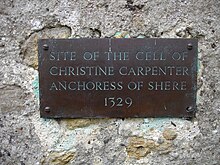Our website is made possible by displaying online advertisements to our visitors.
Please consider supporting us by disabling your ad blocker.
Anchorite



In Christianity, an anchorite or anchoret (female: anchoress; from Ancient Greek ἀναχωρέω (anakhōréō) 'I withdraw, retire') is someone who, for religious reasons, withdraws from secular society to be able to lead an intensely prayer-oriented, ascetic, or Eucharist-focused life. Anchorites are frequently considered to be a type of hermit,[2] but unlike hermits, they were required to take a vow of stability of place, opting for permanent enclosure in cells often attached to churches. Also unlike hermits, anchorites were subject to a religious rite of consecration that closely resembled the funeral rite, following which they would be considered dead to the world and a type of living saint. Anchorites had a certain autonomy, as they did not answer to any ecclesiastical authority apart from bishops.[3][4]
The anchoritic life is one of the earliest forms of Christian monasticism. In the Catholic Church, heremitic life is one of the forms of consecrated life. In medieval England, the earliest recorded anchorites lived in the 11th century. Their highest number—around 200 anchorites—was recorded in the 13th century.[5]
From the 12th to the 16th centuries, female anchorites consistently outnumbered their male counterparts, sometimes by as many as four to one in the 13th century. This ratio eventually dropped to two to one in the 15th century.[6] The sex of a high number of anchorites, however, is not recorded for these periods.[7]
Between 1536 and 1539, the dissolution of the monasteries ordered by Henry VIII of England effectively brought the anchorite tradition to an end in England.[8]
- ^ Cite error: The named reference
Thomas2012was invoked but never defined (see the help page). - ^ "BBC Radio 4 - Making History, The Dunkirk Spirit". BBC. Retrieved 2024-05-13.
- ^
Black, Joseph, ed. (8 September 2011). "Julian of Norwich". The Broadview Anthology of British Literature: Concise Volume A. Vol. 1 (2 ed.). Broadview Press. p. 348. ISBN 9781770480865. Retrieved 22 October 2023.
[...] anchorites and anchoresses did not answer to any ecclesiastical authority other than the bishop.
- ^
Hevelone-Harper, Jennifer L. (19 November 2019) [2017]. "The Letter Collection of Barsanuphius and John". In Sogno, Cristiana; Storin, Bradley K.; Watts, Edward J. (eds.). Late Antique Letter Collections: A Critical Introduction and Reference Guide (reprint ed.). Oakland, California: University of California Press. p. 428. ISBN 9780520308411. Retrieved 22 October 2023.
The correspondence of Barsanuphius and John reveals the anchorites' authority over bishops as well as their submission to bishops.
- ^ "The Code of Canon Law 1983, canon 603".
- ^ McAvoy 2010, p. 11.
- ^ McAvoy, Liz Herbert (2005). Anchorites, Wombs And Tombs : Intersections Of Gender And Enclosure In The Middle Ages. University of Wales. p. 13.
- ^ Rotha, Mary Clay (1914). The Hermits and Anchorites of England. Methuen.
Previous Page Next Page


